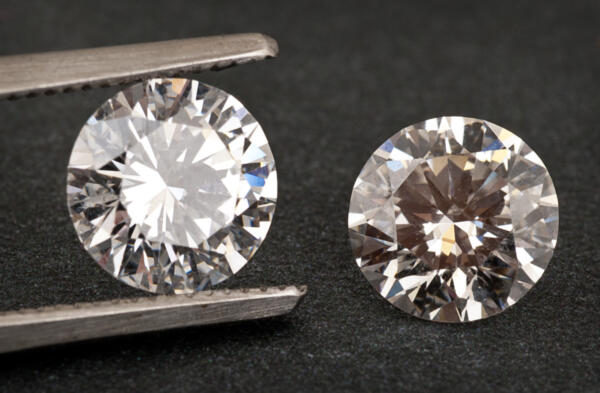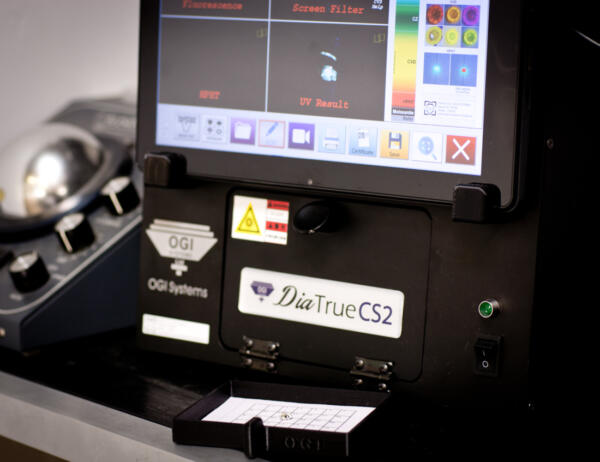How to Tell If a Diamond Is Natural or Lab Grown
Identifying man-made or synthetic diamonds
How can I know if my diamond is real? This is a question we get all the time, and it’s not as simple as you might think. First, you have to decide what “real” means.
If you are not familiar with lab grown diamonds, you might want to check out our introduction to lab grown and synthetic diamonds before continuing with this article. So, now you know that lab grown diamonds are just as real as natural diamonds, but we still want to be able to tell them apart. When it comes to diamond simulants like Cubic Zirconia (CZ) or Moissanite, it is easy to identify them because they aren’t diamonds. But, with lab grown diamonds, the chemical structure and properties are all the same as natural diamond, so it becomes much more difficult to differentiate them.
Responsible Disclosure
The first thing to realize is that most lab grown diamonds are clearly and responsibly disclosed to be synthetic. The big scare in the jewelry industry is non-disclosed lab grown diamonds that are sold as natural diamonds. But, it is important to know that the majority of lab grown diamond manufacturers are perfectly legitimate and honest organizations that are upfront about their products. Some even laser inscribe all of their diamonds to clearly mark them as lab grown.
The Type IIa Test
That said, we would still like to be able to tell if a diamond is natural or lab grown, whether it is disclosed or not. Fortunately, there are some tools available to help us do this. One of the best indicators of whether a diamond is lab grown is whether or not it is a Type IIa diamond. Type IIa is actually a gemological variant of the diamond that relates to how pure the carbon is that makes up the diamond. In nature, less than 2% of all diamonds are Type IIa, however, most gem quality lab grown diamonds are Type IIa. So, if a diamond is Type IIa, that’s a pretty good indication that it is lab grown.
However, like any gemological test, the Type IIa test is only an indicator for the gemologist to use. There are lab grown diamonds that are not Type IIa, and there are natural diamonds that are Type IIa, so it’s not a 100% conclusive test. Also, a diamond has to be completely loose (unmounted) to perform the test.
Photoluminescence Spectroscopy and UV Radiation
Going beyond the Type IIa test, more advanced equipment exists that uses spectroscopic techniques to analyze gems. One such machine is the DiaTrue screener which we have recently added to our own gem lab. This incredible machine is used by some of the world’s top gem labs and jewelry manufacturers daily, and it has already helped us catch undisclosed lab grown diamonds. It does not suffer from many of the limitations of the Type IIa tester, and it even works on diamonds that are set in jewelry. Of course, like all tools, it is not perfect. But, in the hands of our skilled gemologists, it is an absolute game changer.
If you need to be absolutely, 100% sure whether a diamond is lab grown or natural, you can send it to specialized gem labs for testing. DeBeers and GIA (the Gemological Institute of America) have developed even more complex and sophisticated machines for answering this question. They have imaginative names like DiamondCheck, DiamondSure, and DiamondView.
Roughly speaking, these machines work like our DiaTrue. They bombard a diamond with specific types of radiation (nothing harmful to humans) and analyze what the stone outputs. There are certain, tell-tale signs of the various processes used to make lab grown diamonds that show up as spikes and troughs at specific wavelengths in the spectroscopic analysis. With CVD diamonds, the DiamondView machine can even enable a skilled gemologist to see microscopic growth lines where each layer of diamond material was built on the next. The end result is that we can ship a diamond to a GIA gem lab and get back a report telling us with certainty whether or not it is lab grown.
Is My Diamond Lab Grown?
So, should you be worried that your diamond is lab grown and no one told you? Probably not. The vast majority of gem quality synthetic diamonds being produced today are responsibly disclosed and sold as lab grown diamonds. Many major diamond suppliers have even purchased the diamond testing machines we just discussed to screen their inventories for undisclosed lab diamonds. The jewelry industry as a whole has gone to tremendous lengths to ensure that when a diamond is sold as natural, it really is natural.
Plus, when you shop at Arden Jewelers, you have the added benefit of knowing that your diamond was checked by an experienced, GIA trained gemologist. We are one of the only shops in Sacramento with a full gem lab at our disposal including the powerful DiaTrue tester. So, you can buy with confidence knowing our experts have your back.




Can the naked eye tell the difference btwn natural and lab grown diamonds?
Hi Josie, that’s a good question. Typically, the answer is no. Since natural and lab grown diamonds have the same chemical structure, they look the same both to the naked eye and to most gemological tools. That said, some of the inclusions found in lab grown diamonds are very distinct and do not appear in natural diamonds. If the lab diamond in question has one of these inclusions, an experienced gemologist can tell the difference just by looking at it.
Hello, I was wondering, if the lab grown diamond is not Type IIa, which type could it be also. And why are these types not detected with your machine. Thank you for your advice.
Good question, Vinci. There are different types of diamonds (Type I and II with a and b variants of each). The different types correlate to different kinds of impurities that are found in the diamond’s crystal lattice. The earlier Type IIa tester worked by looking for the unique light signature given off by Type IIa diamonds (most of which are lab grown). The newer machine mentioned in the article is more sophisticated and is able to detect lab grown diamonds of any type.
how much does your diamond tester cost?
Good question, Karen. Our current tester cost over $5,000 and is able to differentiate many different kinds of lab grown diamonds and diamond simulants. The Type IIa tester mentioned in the article above is a simpler device that I believe cost less than $1,000.
Hi there, where are lab grown diamonds grown? Which countries produce these and where are the majority labs that grow them located?
Hi Allegra, all good questions. Lab grown diamonds are produced all over the world with large manufacturing facilities in the USA, China, Russia, and other countries. In recent years, the technology has become more affordable and we have seen an explosion of new manufacturers.
When a seller advertises that a diamond is genuine, is that the same claim as a seller advertising a natural diamond?
Hi John, that’s a tough question these days. There is a general, default, assumption that a diamond is natural unless it’s described as lab grown. That said, the increase in popularity of lab grown diamonds has complicated things, so I would clarify the origin of the diamond with the company just to be sure.
Does a man-made diamond hold its value when you resell it?
Hi Chassidy, that is a great question. The lab grown diamond market is still fairly young, so it’s hard to say how they will hold their value long term. That said, we have seen prices drop since lab grown diamonds first hit the market, and as technology improves it seems likely that this trend will continue at least in the short term. Beyond that it’s hard to say. At this point, we are seeing natural diamonds hold their resell value better than comparable lab grown diamonds.
So technically a lab grown diamond should detect as real on a diamond detector? What if it doesn’t? Does that mean the lab grown has been sold as a different composite?
Hi Katy, good question. It just depends on the type of diamond tester we are talking about. If a lab grown diamond doesn’t test as diamond on an old-fashioned thermal tester, then it is not actually a lab grown diamond. It would be a diamond simulant (checkout our article on what are lab grown diamonds for more). On the other hand, advanced spectroscopic machines are able to differentiate between natural and lab grown diamonds, so it would not be surprising for a lab grown stone to test as a lab grown on a machine like that.
I think a major Dimond Manufacture got duped on a 2.7 CW lab grown last year that was sent in for testing…. Buyer be Aware.
Hello Mr Miller, thanks for chiming in. We have heard of a small number of undisclosed lab grown diamonds being sold as natural with most of these being smaller melee or accent diamonds. Of course, it’s always possible for a larger stone to be misidentified but most of the larger diamond dealers and laboratories now have sophisticated screening machines and processes in place, so the chance of this happening today is getting very low.
I was told that my diamond has a feather in it when they were appraising it? Is this good or bad?
Hello Trudy, that’s a good question. A feather is a type of inclusion in a diamond (see our article on the 4 C’s of diamonds). It is usually white or clear and fully contained in the diamond (i.e. it doesn’t break the surface). It’s amoral so it’s neither good nor bad. Think of it as a way to identify your diamond, and get to know its shape and location so that you can recognize your diamond whenever you look at it. It may be so small that you have to use a 10 power loupe to see it.
Awesome article well written!!!